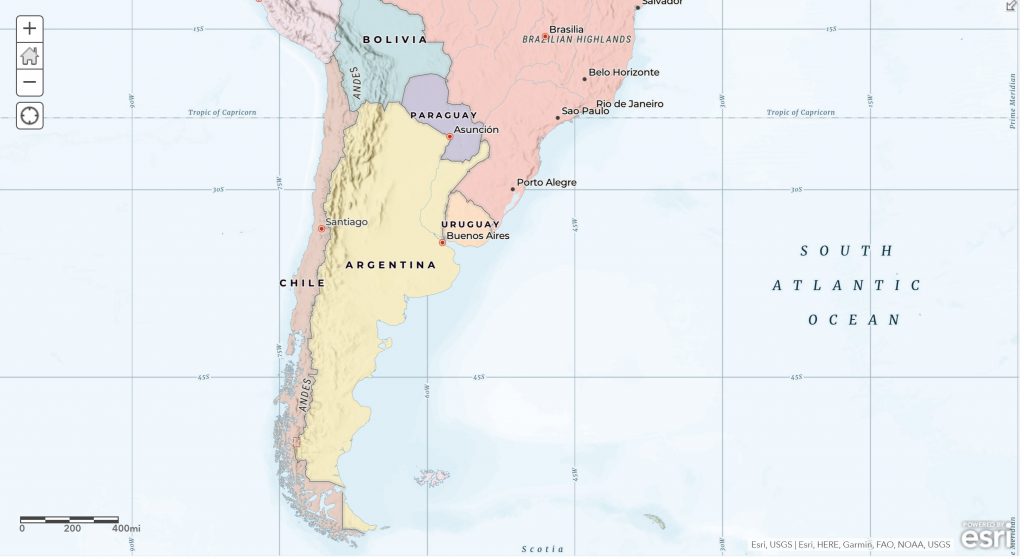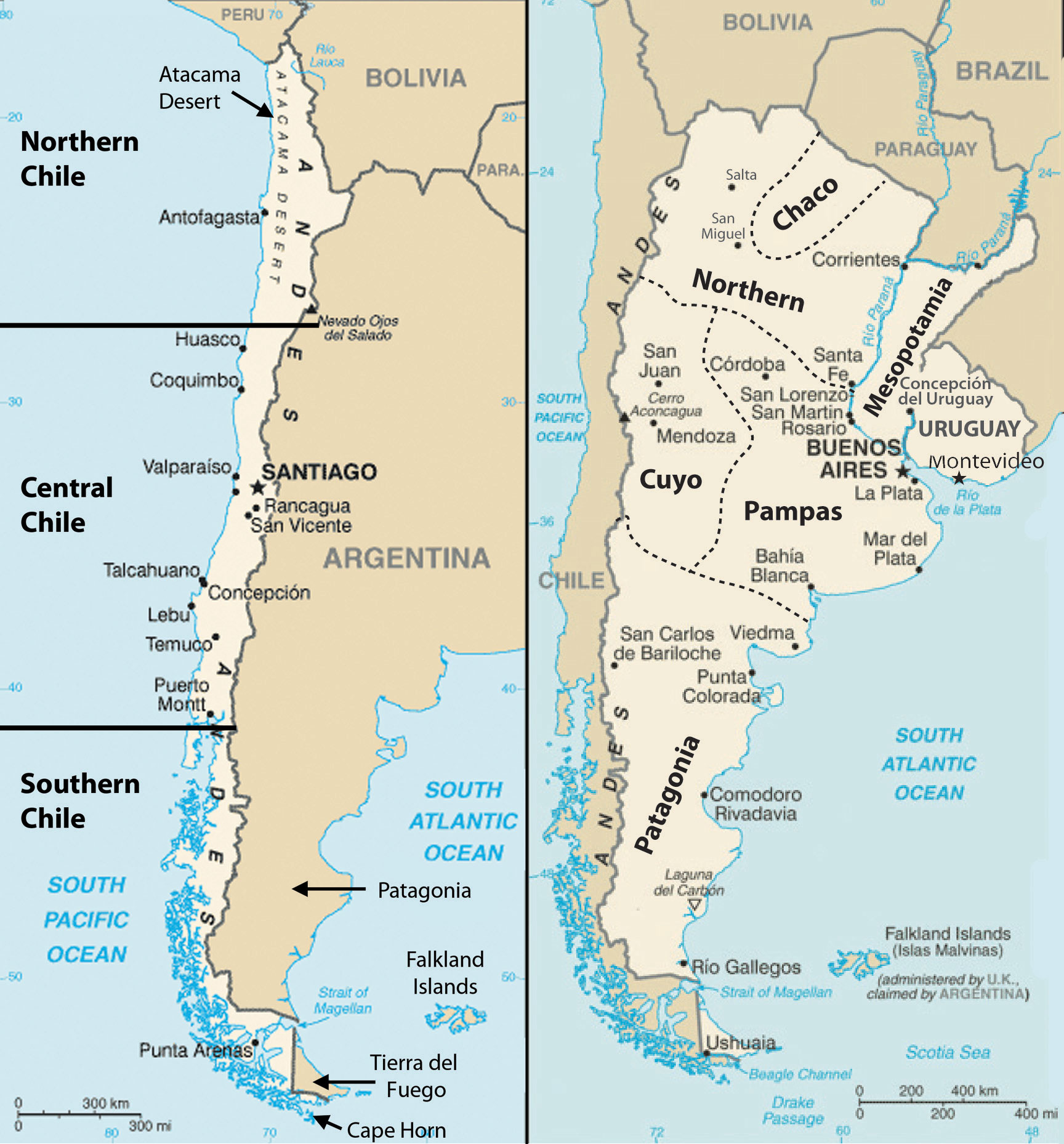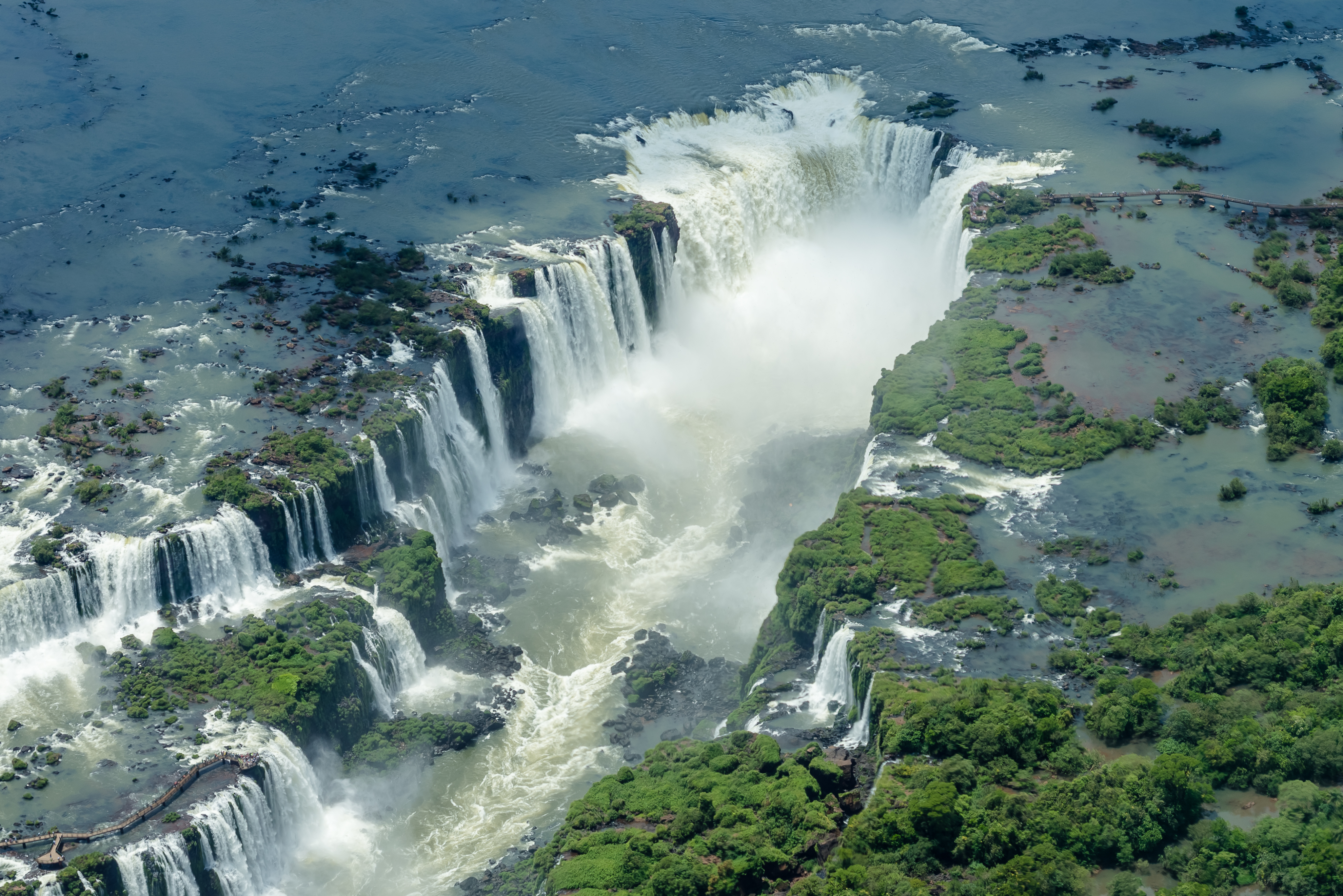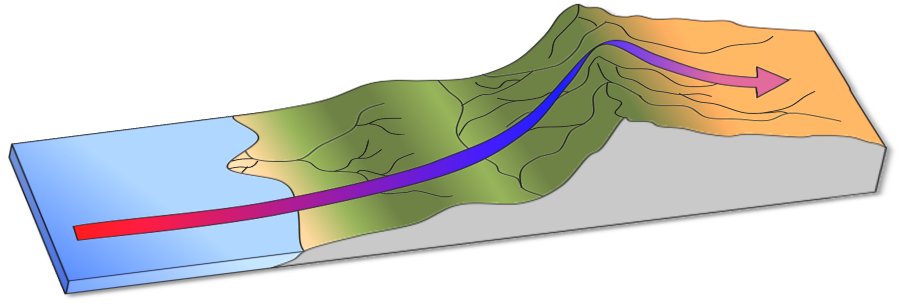South America
7.6 The Southern Core

The Southern Cone region of South America includes the countries of Uruguay, Argentina, and Chile. The name is an indication of the physical shape of the southern portion of the continent. The region is located south of the tropics. The Tropic of Capricorn runs north of Uruguay and cuts across the northern regions of Argentina and Chile. The region has extreme weather and climate, where the Southern Cone has more moderate temperatures than the tropics. Type C climates dominate in Uruguay, the Pampas region of Argentina, and central Chile. The Atacama Desert and Patagonia both have type B climates because of a lack of precipitation, which stems from the rain shadow effect of the Andes Mountains. Highland type H climates follow the Andes chain through the region and exhibit their typical pattern of warmer temperatures at lower elevations and colder temperatures at higher elevations.

The countries of the Southern Cone share similar economic and ethnic patterns. Agriculture has been a significant focus of the region’s early development pattern, but today a large percentage of the population is urbanized. The European heritage of most of the population ties this region to Europe as an early trading partner. The global economy has given cause for these countries to form trade relationships with many countries. Physical geography has provided many opportunities for human activities. The mountains, plains, and coastal areas provide a diversity of natural resources that have been exploited for national wealth. All three countries have primate cities that hold a high percentage of the country’s population. Primate cities are usually twice as large as the next largest city and usually are exceptionally expressive of national feelings and culture. In this case, all three primate cities are also the capital cities of each country. The Southern Cone is an urban region with higher incomes and higher living standards than many other parts of South America.
Uruguay
Uruguay is located along the South Atlantic coast bordering Argentina and Brazil. The only South American country smaller in the physical area is Suriname. French Guiana is also smaller than Uruguay but remains a part of France. Uruguay has the location, natural resources, and global trade connections to provide ample opportunities and advantages for its people. The Pampas’ agricultural lands extend into Uruguay and provide for an extensive agricultural industry with livestock, small grains, vegetables, and dairy. This agricultural base has been the foundation of Uruguay’s growing economy.
Uruguay has been able to integrate itself into the global trade arena and has entered into a postindustrial development status. Postindustrial activities have included computer software development and advancements in information technologies. Uruguay is a modern and well-developed country. About 88 percent of the population is of European descent, and more than 92 percent of the population is urban. The capital city of Montevideo, a cosmopolitan city with a population of about 3.5 million, is home to about 40 percent of the population. The coastal region is an attractive place for tourists and locals who enjoy the beautiful beaches along the shores of the Atlantic.
Montevideo is also the location of the headquarters for Mercosur (the Southern Cone Common Market). Mercosur was created in 1991 to open trade of goods and services among South American countries and promote development within the realm. Current members of Mercosur include Uruguay, Paraguay, Brazil, and Argentina. Venezuela’s application for full membership is pending. Additional associate members of Mercosur include Peru, Ecuador, Colombia, Chile, and Bolivia. Mercosur is on a parallel path to compete with the North American Free Trade Agreement (NAFTA), the Central America Free Trade Agreement (CAFTA), the European Union, and other global trade associations.
Argentina
South America’s second-largest country is Argentina. In the physical size, Argentina is ranked eighth in the world. The Andes Mountains span its entire western border with Chile. At the southern end of the continent in Tierra del Fuego. Argentina is a land of extremes. Mt. Aconcagua is the highest mountain in the Western Hemisphere at 22,841 feet in elevation, and Laguna del Carbon is the lowest point in the Western Hemisphere at −344 feet below sea level. Parts of the northern region have a tropical climate; the southern region extends into tundra-like conditions with treeless plains. Argentina also claims the Falkland Islands, which are now controlled by Great Britain. In 1982, Argentina’s ruling military junta attempted to retake control of the Falklands, but the British navy halted the action in what became known as the Falklands War.
Physical Regions
Argentina can be categorized into several regions that correlate roughly with the country’s varied physical and cultural landscapes. The central regions include Chaco, Northern, Mesopotamia, Cuyo, Pampas, and Patagonia. The Northern region of Argentina has one of the highest average elevations because of the Andes Mountain Ranges. The Andes ranges widen as they proceed northward to the west of Chaco and are home to fertile river valleys. The northern ends of the ranges extend into Bolivia and enter the Altiplano of the Central Andes.
The Chaco region, which is formally called the Gran Chaco, extends from northern Argentina into western Paraguay. Scrublands and subtropical forests dominate the landscape. There is a wet season as well as a dry season suitable for raising livestock and some farming. Western Chaco, which is closer to the Andes, is drier with less vegetation and is known for its high temperatures during the summer months. To the east, the Chaco region receives more rainfall and has better soil for agriculture. The agrarian lifestyle dominates the cultural heritage of this region. In the 1920s and 1930s, the Chaco region attracted many Mennonite immigrants from Canada and Russia, who established successful farming operations mainly on the Paraguay side of the border and also extending into Argentina.
On the east of the northern region, on the other side of the Paraná River and reaching the banks of the Uruguay River, it is the region called Mesopotamia, whose name means “between rivers.” This unique region has a variety of features, from flatlands for grazing livestock to subtropical rain forests. The most noteworthy feature is the expansive Iguazú Falls on the Iguazú River, located on the border of Brazil and Argentina. It is a series of 275 parallel waterfalls that are just short of two miles across. It has the highest average annual flow of any waterfall in the world. Most of the falls are more than 210 feet high; the tallest is 269 feet. The spectacular Iguazú Falls is a major tourist attraction, drawing people from all over the world.

The headwaters of the Iguazú River are near Curitiba in Brazil. The river converges with the Paraná River about 14 miles downstream from the Iguazú Falls at the point where Brazil, Paraguay, and Argentina meet—called the Triple Frontier. The falls are approximately 1.7 miles along its edge, divided by rocky islands on both the Argentinean and Brazilian sides. The Iguazú Falls is a major tourist attraction for the region.
The Cuyo region is located along the Andes Mountains in the west-central part of the country. Mt. Aconcagua is located here, along with other high mountain peaks. This arid region gets most of its moisture from melting snow off the mountains, which irrigates the fertile agricultural lands that produce fruits and vegetables. The Cuyo is a major wine-producing region; it accounts for up to three-quarters of its production. Mendoza is the country’s fourth-largest city. Low mountain ranges form the eastern border between the Cuyo and the Pampas, making for picturesque vineyards and farms.
The Pampas is a vast agricultural region that extends beyond Argentina and includes a large portion of Uruguay and Brazil’s southern tip. With adequate precipitation and a mild type C climate, the Pampas is well suited for both agriculture and human habitation. The fertile agricultural lands of the Pampas include the largest city and the country’s capital, Buenos Aires, which is home to up to a third of the nation’s population. The Pampas pro-vides some of the most abundant agricultural production on the planet. The western grass-lands host large haciendas (prestigious agricultural units) with cattle ranching and livestock production. This area has elevated Argentina to its status as a major exporter of beef around the world. Agricultural production has been a significant part of the nation’s economy. One hundred years ago, the export of food products made Argentina one of the world’s wealthiest countries. In today’s global economy, the profit margins in agricultural products are not as lucrative, and industrialized countries have turned to manufacturing for national wealth. Argentina continues to have a robust agricultural sector but has been increasing its industrial production to secure a strong economy.
Patagonia is a vast expanse of the south that is semiarid because of the rainshadow effect. This area possesses enormous natural resources, including large amounts of oil and natural gas. Deposits of gold, silver, copper, and coal can be found here. Raising livestock has been the main livelihood in Patagonia, which is otherwise sparsely populated. Patagonia includes the southern region of Tierra del Fuego and the rugged Southern Andes, which have some of the most extensive ice sheets outside Antarctica and many massive glaciers that provide fresh water that feeds the region’s streams and rivers. Patagonia also has several scenic lakes. Abundant wildlife can be found along the Atlantic coast, including elephant seals, penguins, albatrosses, and a host of other species. This region demonstrates that Argentina is blessed with a variety of physical landscapes and natural resources to help support its economy and its people.

Population and Culture
With a population of about forty million, Argentina is a country of immigrants and a product of the colonial transfer of European culture to the Western Hemisphere. During the colonial era, millions of people immigrated to Argentina from Western European countries such as France, Germany, Switzerland, Portugal, Greece, the British Isles, and Scandinavia. Additional immigrants came from Eastern Europe and Russia. Eighty-five percent of the population is of European descent; the largest ethnic groups are Spanish and Italian. The Mestizo population is only about 8 percent. A small number of people from the Middle East or East Asia have immigrated and made up about 4 percent of the population. Less than 2 percent of Argentines declare themselves to be Amerindians.
Old World European customs mix with New World Latin American traditions to form a cultural heritage unique to Argentina. This cultural heritage can be experienced in the metropolitan city of Buenos Aires, where all facets of society and culture can be found. With a population of about thirteen million—one-third of Argentina’s total population—Buenos Aires is a world-class city. Argentina is an urban country: more than 90 percent of the population lives in cities. The rural side of the culture has often been characterized as the traditional gaucho (cowboy) image of the self-reliant rancher who herds cattle and lives off the land. Beef is a mainstay of the cuisine in much of the country. The urban culture includes the traditional Argentine tango with music and camaraderie in upscale night clubs. These traditional images may be stereotypes, but Argentina’s cultural scene is heavily invested in the international trends of the modern world. The cultural landscape has become integrated with fashions and trends from across the globe.
People and Politics
The people of Argentina have a good standard of living, and the country is up-and-coming on a world scale. The main problem has been the instability of the government during the twentieth century. The Argentine constitution provides a balance of powers between the judicial, legislative, and executive divisions, similar to that of the United States. For many decades in the twentieth century, the state vacillated between a democratically elected government and military rule. The swings back and forth have been consistent and regular, which has wreaked havoc on the economy, resulting in everything from hyperinflation to brutal authoritarian rule.
An example of the national swings in Argentina occurred between 1946 and 1955, when General Juan Perón was elected president. His wife, Eva (popularly known as Evita), became a public sensation. “Peronism” started with populous support and a shift toward improving working conditions and increasing government spending. Simultaneously, censorship, isolationism, and repression of civil rights were elevated to the point of social unrest. Opposition members were imprisoned or killed. Eva Perón died of cancer in 1952, and Juan Perón was eventually ousted from office and fled to Spain. He later returned from exile to gain prominence in politics once again but died in office in 1974. Other presidents came to power only to be deposed or ousted by military coups. The instability in the political arena created problems for the economic sector, which had to deal with inflated currency and an unattractive environment for foreign investments. More recently, there has been some progress in stabilizing both the government and the economy, but political instability remains a factor. Argentina has abundant natural resources, adequate infrastructure, and an educated workforce. The country has all the necessary means to launch into the future with a strong economy – as long as it can establish a stable government and a sound economic agenda.
Chile
Chile is a long, narrow country on the western edge of southern South America. The country is 2,500 miles long and only 90 miles wide on average. It borders the Pacific Ocean on one side and the Andes Mountains on the other. Chile has a variety of environmental zones, administrative districts, and climate patterns. Temperatures are cooler as one moves south toward Tierra del Fuego, which is split between Chile and Argentina. Rain has never fallen in select areas of northern Chile, including the Atacama Desert, one of the driest places on Earth and home to one of the world’s most significant copper and nitrate reserves. The sodium nitrates found in the Atacama Desert are used in plant fertilizers, pottery enamels, and solid rocket fuel.
Rain Shadow Effect
Orographic uplift is when mountains help destabilize air and occur when air must rise over a mountain range. As the air rises over the mountain, the moisture within it may begin to cool and condense to form thunderstorms. Often with orographic uplift, one side of the mountain will be very moist from the storms, while the other side is arid. The dry side of the mountain is called the rainshadow effect. Later we will discuss how this process can generate what is called dry thunderstorms and wildfires.


The climate is due to the rainshadow effect. In northern Chile and the Atacama region, prevailing winds reach northern Chile from the east and hit the Andes Mountain chain, which is some of the highest mountains on the continent. The height of the Andes causes any moisture from rain clouds to precipitate on the eastern slopes. The western side of the Andes Mountains at that latitude receives little or no precipitation, causing extreme desert conditions in the Atacama region of Chile. Southern Chile receives a large amount of rainfall because the prevailing winds at that latitude come from the west. Here the winds, which have picked up moisture over the South Pacific Ocean, hit the western side of the Andes. The air then precipitates its moisture as it rises the mountainsides of the western slopes of the Andes. Less moisture reaches the eastern side of the mountains, creating a rain shadow with arid and dry conditions for the region called Patagonia in southern Argentina. The Andes are not as high in elevation in the south, which allows some precipitation to fall on the rain shadow side.

Chile can be divided into three regions:
- Northern Chile, with the dry Atacama Desert
- Central Chile, with a mild Type-C climate, adequate rainfall, and good farmland
- Southern Chile, with lots of rainfall, rural, isolated islands, and mountains
Central Chile is the core region because it has a valuable port in Valparaiso and the country’s capital city, Santiago, Chile’s most populous city. Central Chile is also home to more than 90 percent of the country’s population.
Socioeconomic Conditions
The people of Chile are 95 percent European and Mestizo. They have worked to establish a sound education system and an increasing standard of living. The country had a relatively stable government until the 1970s when a short revolution brought a military dictatorship to power until 1989. The 1990s brought about a surge in economic development that has continued into the twenty-first century. The political situation has stabilized, and the first female president, Michelle Bachelet, was elected in 2006. The political system is faced with the unequal distribution of wealth common in Latin America and many other countries of the world. Half the country’s wealth is concentrated in the hands of about 10 percent of the population. About 50 percent of the population is on the lower end of the socioeconomic scale. Dire poverty exists in Chile, but it is not as prevalent here as it is in the Central Andes, Paraguay, or Northeast Brazil. Chile has a thriving middle class that has made good use of Chile’s opportunities and education.
Chile is blessed with natural resources that include the minerals of the Atacama Desert, extensive fishing along the coast, timber products from the south, and agricultural products from central Chile. All these factors have brought about an emerging development boom and have attracted international trading partners. The stable government and the growing economy have successfully kept inflation low, kept employment high, reduced poverty, and brought foreign investment. In the globalized economy, Chile has managed to work with various trading partners to increase its advantages and opportunities in the international marketplace.
Trade
Chile has been increasing its trading activities with its counterparts in the Pacific Rim in Europe and North America. Chile has an abundance of fish in its coastal waters and copper and minerals in the Atacama Desert and has been exporting timber products from its southern region. The United States is one of Chile’s main trading partners. Chile’s main commodity exports to the United States include paper, minerals, metals, and copper. Major agricultural products that are shipped to the United States include processed fruits, tomatoes, grapes, vegetables, and wines. There are several good reasons why the United States trades with Chile even though it is the farthest country from the United States in South America. International trade and the seasonal patterns of agriculture have much to do with the benefits. The seasonal variations between the northern and southern hemisphere create a balance between the two. When it is winter in the north, it is summer in the south. Each has an op-posing growing season for fruits and vegetables that can complement the other. Chile is an excellent counter to the opposite growing season in the Northern Hemisphere.
In 1994 during a summit meeting, the president of Mexico, Canada’s prime minister, and the US president agreed to allow Chile to join the North American Free Trade Agreement (NAFTA). Chile’s president declared his support for his country to join NAFTA. The agreement could not be completed because of negotiation approval by the US Congress. At this time, Chile entered into independent free trade agreements with both Canada and Mexico. A free trade agreement was later signed between the US and Chile in 2003. Thus, Chile has free trade agreements with all three North American countries and can benefit from the mutual agreements that parallel NAFTA. In this situation, Chile is an associate trading partner and enjoys the privileges of NAFTA membership without technically being listed as a member. The United States was looking to counter Chile’s trade with Japan and Europe. Increased trade with North America diminished Chile’s trade with the European Union or the East Asian community.
As copper and natural resource prices fluctuate, creating unstable economic conditions, Chile has been expanding into the manufacturing sector. To retain the highest value-added profits and expand its economy, Chile will have to enlarge its manufacturing sector. Today Chile produces modest quantities of necessary chemicals and electronic goods. Chile’s expansion of business and commerce has been endorsed as a successful economic development model to be emulated by other Latin American countries.
Chile has strong ties to North America’s economies, but despite close ties with the north, Chile has retained its unique status in the Southern Cone. Chile still has its currency even though countries with smaller economies, such as Ecuador and El Salvador, have adopted the US dollar as their medium of exchange. As of 2020, under the new United States-Mexico-Canada-Agreement (USMCA), members of Canada, the United States, and Mexico, along with their trading partner of Chile, all used different currencies. Chile has individual free-trade agreements with all three members of the USMCA, so any change in currency with the USMCA countries would also affect Chile.

